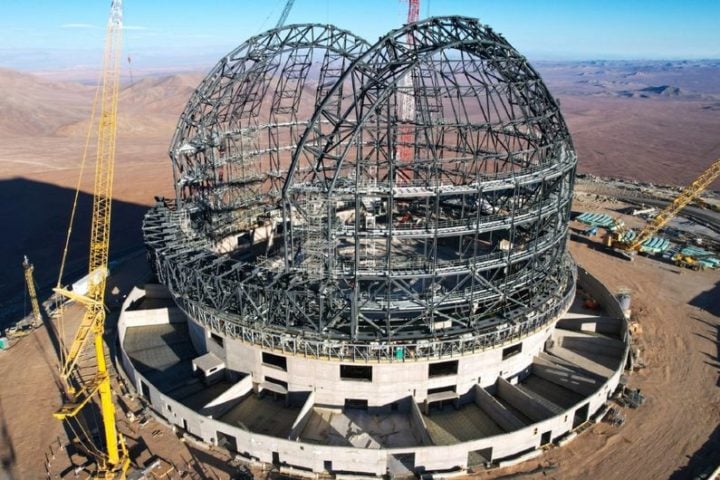In 2014, the European Southern Observatory (ESO) began constructing the world’s largest telescope, the Extremely Large Telescope (ELT), in Chile’s Atacama Desert, 3,000 metres above sea level. The giant eye on the sky promises to usher in a new era in ground-based astronomy when it becomes operational in 2028.

The ELT dome under construction in Chile. Image credit: ESO/G. VECCHIA
On June 5, ESO signed an agreement with a consortium of organizations from 13 countries for the design and construction of the ArmazoNes high Dispersion Echelle Spectrograph (ANDES), to be installed on the ELT. ANDES is an instrument that will be used to search for signs of life on exoplanets and look for the very first stars, as well as to test variations in the fundamental constants of physics and measure the acceleration of the expansion of the Universe.
A Canadian team based at Université de Montréal and co-led by Professor René Doyon is a key contributor to this groundbreaking near-infrared spectrograph project.
What is a spectrograph?
A spectrograph is an instrument that splits light into its component wavelengths so astronomers can determine important properties of celestial objects, such as their chemical composition.
ANDES will be a particularly powerful instrument with record-high precision in the visible and near-infrared regions of light. When working in combination with the ELT’s powerful mirror system, it will open doors for research spanning multiple areas of astronomy.
It will be able to conduct detailed surveys of the atmospheres of Earth-like exoplanets, allowing astronomers to search extensively for signs of life.
It will also be able to analyze the chemical elements present in distant objects in the young Universe, making it probably the first instrument capable of detecting the signatures of Population III stars, the first stars in the Universe.
In addition, astronomers will be able to use ANDES data to test whether the fundamental constants of physics vary with time and space. Its comprehensive data will also be used to directly measure the acceleration of the Universe’s expansion, one of the most enduring mysteries of the cosmos.
Canada’s contribution to the search for extraterrestrial life
The Canadian team involved in ANDES is led by the Mont-Mégantic Observatory and its Experimental Astrophysics Laboratory, under the leadership of René Doyon, the team’s co-principal investigator and professor of astrophysics at UdeM.
The project also includes design work from the National Research Council’s Herzberg Astronomy and Astrophysics Research Centre, all working in close collaboration with the Canadian ANDES science team co-led by Doyon and Professor Kim Venn from the University of Victoria, the project’s other co-principal investigator.
The Canadian team is deeply involved in the development of the near infrared spectrograph, as well as the adaptive optics and control systems, data reduction pipeline, and in the provision of highly skilled scientific personnel.
The ambitious goals of ANDES, such as detecting life signatures in exoplanet atmospheres and studying the Universe’s first stars, strongly align with the cutting-edge research conducted by Canadian scientists, particularly at UdeM’s Trottier Institute for Research on Exoplanets (iREx), Canada’s top exoplanet research centre.
This collaboration showcases Canada’s strong capabilities in the field of infrared astronomy and underscores the country’s leadership in astrophysical research and its commitment to advancing our understanding of our Universe.
“ANDES will significantly impact all fields of astrophysics with its unique ability to detect the spectral signatures of life in the atmospheres of potentially habitable exoplanets near the Sun,” said Doyon. “It will also actively engage the Canadian astronomical community in utilising the ELT, which is set to become operational in a few years.”
Canada was asked to participate in the project because of the extensive infrared expertise developed at the Mont-Mégantic Observatory’s Experimental Astrophysics Laboratory: “This participation allows Canadian scientists to contribute to the design and construction of an instrument for the world’s largest telescope, granting Canadian astronomers valuable observing time to deepen our understanding of the Universe,” said astrophysicist Frédérique Baron, project manager of the Canadian instrument team at UdeM.
Source: University of Montreal

